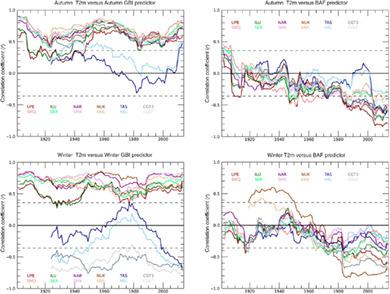当前位置:
X-MOL 学术
›
Int. J. Climatol.
›
论文详情
Our official English website, www.x-mol.net, welcomes your
feedback! (Note: you will need to create a separate account there.)
The role of blocking circulation and emerging open water feedbacks on Greenland cold‐season air temperature variability over the last century
International Journal of Climatology ( IF 3.5 ) Pub Date : 2020-11-05 , DOI: 10.1002/joc.6879 Thomas J. Ballinger 1 , Edward Hanna 2 , Richard J. Hall 3 , J. Rachel Carr 4 , Saber Brasher 5 , Erich C. Osterberg 6 , John Cappelen 7 , Marco Tedesco 8, 9 , Qinghua Ding 10 , Sebastian H. Mernild 11, 12, 13, 14
International Journal of Climatology ( IF 3.5 ) Pub Date : 2020-11-05 , DOI: 10.1002/joc.6879 Thomas J. Ballinger 1 , Edward Hanna 2 , Richard J. Hall 3 , J. Rachel Carr 4 , Saber Brasher 5 , Erich C. Osterberg 6 , John Cappelen 7 , Marco Tedesco 8, 9 , Qinghua Ding 10 , Sebastian H. Mernild 11, 12, 13, 14
Affiliation

|
Substantial marine, terrestrial, and atmospheric changes have occurred over the Greenland region during the last century. For example, several efforts have documented record-levels of Greenland Ice Sheet (GrIS) summer melt extent and intensity during the 2000s and 2010s, but relatively little work has been carried out to assess regional climatic changes in other seasons. Here, we focus on the less studied cold-season (i.e., autumn and winter) climate, tracing the long-term (1873–2013) variability of Greenland’s air temperatures through analyses of coastal observations and model8 derived outlet glacier series and their linkages with North Atlantic sea ice, sea surface temperature (SST), and atmospheric circulation indices. Through a statistical framework, large amounts of west and south Greenland temperature variance (up to r2~50%) can be explained by the seasonally contemporaneous combination of the Greenland Blocking Index (GBI) and the North Atlantic Oscillation (NAO; hereafter GBI). Lagged and concomitant Baffin sea-ice concentration (SIC) and the Atlantic Multidecadal Oscillation (AMO) seasonal indices account for small amounts of air temperature residual variance (r2<~10%) relative to the GBI. The correlations between GBI and autumn and winter air temperatures are predominantly positive and statistically-significant through time, while Baffin SIC conditions emerge as a significant covariate from the mid-20th century through the conclusion of the study period. The inclusion of the cold-season Pacific Decadal Oscillation (PDO) in multivariate analyses bolsters the air temperature variance explained by the North Atlantic regional predictors, suggesting the remote, background climate state is important to long-term Greenland temperature variability. These findings imply that large-scale tropospheric circulation has a strong control on surface temperature over Greenland through dynamic and thermodynamic impacts and stress the importance of understanding the evolving two-way linkages between the North Atlantic marine and atmospheric environment in order to more accurately predict Greenland seasonal climate variability and change through the 21st century.
中文翻译:

阻塞环流和新出现的开放水域反馈对上个世纪格陵兰冷季气温变化的影响
上个世纪,格陵兰地区发生了巨大的海洋、陆地和大气变化。例如,有几项努力记录了 2000 年代和 2010 年代格陵兰冰盖 (GrIS) 夏季融化范围和强度的创纪录水平,但评估其他季节区域气候变化的工作相对较少。在这里,我们专注于研究较少的冷季(即秋季和冬季)气候,通过分析沿海观测和模型 8 导出的出口冰川系列及其与格陵兰岛的联系,追踪格陵兰岛气温的长期(1873-2013 年)变化。北大西洋海冰、海面温度 (SST) 和大气环流指数。通过统计框架,格陵兰岛西部和南部的大量温度变化(高达 r2~50%)可以通过格陵兰阻塞指数 (GBI) 和北大西洋涛动 (NAO;以下简称 GBI) 的季节性同期组合来解释。滞后和伴随的巴芬海冰浓度 (SIC) 和大西洋年代际振荡 (AMO) 季节性指数导致相对于 GBI 的少量气温残差 (r2<~10%)。GBI 与秋季和冬季气温之间的相关性主要是随着时间的推移呈正相关且具有统计显着性,而巴芬 SIC 条件从 20 世纪中叶到研究期结束时作为一个重要的协变量出现。将冷季太平洋年代际振荡 (PDO) 纳入多变量分析支持北大西洋区域预测因子解释的气温变化,表明偏远的背景气候状态对格陵兰岛的长期温度变化很重要。这些发现意味着大规模对流层环流通过动力和热力学影响对格陵兰的地表温度有很强的控制,并强调了解北大西洋海洋和大气环境之间不断变化的双向联系以更准确地预测格陵兰的重要性21 世纪的季节性气候变率和变化。背景气候状态对格陵兰岛的长期温度变化很重要。这些发现意味着大规模对流层环流通过动力和热力学影响对格陵兰的地表温度有很强的控制,并强调了解北大西洋海洋和大气环境之间不断变化的双向联系以更准确地预测格陵兰的重要性21 世纪的季节性气候变率和变化。背景气候状态对格陵兰岛的长期温度变化很重要。这些发现意味着大规模对流层环流通过动力和热力学影响对格陵兰的地表温度有很强的控制,并强调了解北大西洋海洋和大气环境之间不断变化的双向联系以更准确地预测格陵兰的重要性21 世纪的季节性气候变率和变化。
更新日期:2020-11-05
中文翻译:

阻塞环流和新出现的开放水域反馈对上个世纪格陵兰冷季气温变化的影响
上个世纪,格陵兰地区发生了巨大的海洋、陆地和大气变化。例如,有几项努力记录了 2000 年代和 2010 年代格陵兰冰盖 (GrIS) 夏季融化范围和强度的创纪录水平,但评估其他季节区域气候变化的工作相对较少。在这里,我们专注于研究较少的冷季(即秋季和冬季)气候,通过分析沿海观测和模型 8 导出的出口冰川系列及其与格陵兰岛的联系,追踪格陵兰岛气温的长期(1873-2013 年)变化。北大西洋海冰、海面温度 (SST) 和大气环流指数。通过统计框架,格陵兰岛西部和南部的大量温度变化(高达 r2~50%)可以通过格陵兰阻塞指数 (GBI) 和北大西洋涛动 (NAO;以下简称 GBI) 的季节性同期组合来解释。滞后和伴随的巴芬海冰浓度 (SIC) 和大西洋年代际振荡 (AMO) 季节性指数导致相对于 GBI 的少量气温残差 (r2<~10%)。GBI 与秋季和冬季气温之间的相关性主要是随着时间的推移呈正相关且具有统计显着性,而巴芬 SIC 条件从 20 世纪中叶到研究期结束时作为一个重要的协变量出现。将冷季太平洋年代际振荡 (PDO) 纳入多变量分析支持北大西洋区域预测因子解释的气温变化,表明偏远的背景气候状态对格陵兰岛的长期温度变化很重要。这些发现意味着大规模对流层环流通过动力和热力学影响对格陵兰的地表温度有很强的控制,并强调了解北大西洋海洋和大气环境之间不断变化的双向联系以更准确地预测格陵兰的重要性21 世纪的季节性气候变率和变化。背景气候状态对格陵兰岛的长期温度变化很重要。这些发现意味着大规模对流层环流通过动力和热力学影响对格陵兰的地表温度有很强的控制,并强调了解北大西洋海洋和大气环境之间不断变化的双向联系以更准确地预测格陵兰的重要性21 世纪的季节性气候变率和变化。背景气候状态对格陵兰岛的长期温度变化很重要。这些发现意味着大规模对流层环流通过动力和热力学影响对格陵兰的地表温度有很强的控制,并强调了解北大西洋海洋和大气环境之间不断变化的双向联系以更准确地预测格陵兰的重要性21 世纪的季节性气候变率和变化。











































 京公网安备 11010802027423号
京公网安备 11010802027423号